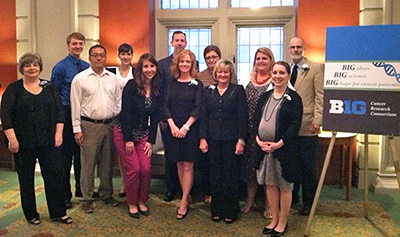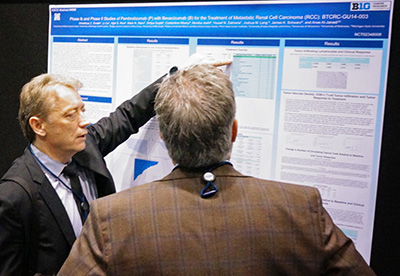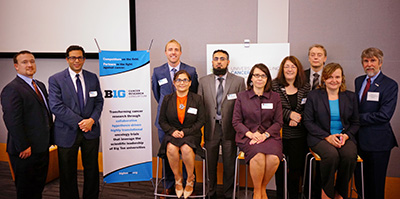Sept. 10, 2018:
History has its transformative moments – instances that radically shape the future. Looking back, we see their significance, but in the moment their impact is still unseen. As the Big Ten Cancer Research Consortium (Big Ten CRC) celebrates its fifth year in 2018, we pause to reflect on milestones past and those on the horizon, through the words of some of our founding visionaries.
Creative energy sparks a game-changing idea.
“I was at an NCI cancer directors meeting in the Washington area, staying at a local hotel with nothing to do at night, surfing channels,” recalls Steven T. Rosen, MD, provost and chief scientific officer of City of Hope and former director of the Robert H. Lurie Comprehensive Cancer Center of Northwestern University. “I saw the Big Ten Network and it was like a lightbulb went on – the power of that significant group of institutions and what they could accomplish together.”
“Because there are so many NCI designated cancer centers in the Big Ten, this seemed like a slam dunk,” says Patrick J. Loehrer, Sr., MD, director of the Indiana University Melvin and Bren Simon Cancer Center.
Immediately, Rosen and Loehrer gathered other Big Ten cancer center directors to discuss. “I said, ‘Do you know what we have in common?’ Initially they didn’t see the association and then I said we are the Big Ten, and this is a great opportunity to network,” recalls Rosen.
“It reflected the spirit of collaboration, competitiveness, and bringing in the brain trust of these institutions, which is quite deep, and the intent of course is to help patients,” says Maha Hussain, deputy director of the Lurie Cancer Center.
Sheer excitement pours on the fuel.

Big Ten CRC Administrative Headquarters staff and consortium leaders at the Big Ten CRC kickoff event during ASCO 2013.
“The June 2013 kickoff at ASCO — I am not easily impressed, and I was over the moon. It was phenomenal,” recalls Tim Volpe, former associate director for administration at the Lurie Cancer Center.
Competitors become partners.
In 2013 the Big Ten cancer centers united to transform the conduct of cancer research through collaborative, hypothesis-driven, highly translational oncology trials that leverage the scientific and clinical expertise of Big Ten universities. Since its inception, the goal of the Big Ten Cancer Research Consortium has been to create a unique team-research culture to drive science rapidly from ideas to new approaches to cancer treatment. Within this innovative environment, today’s research leaders collaborate with and mentor the research leaders of tomorrow with the unified goal of improving the lives of all patients with cancer.
The unity of purpose proved productive. “The spirit that we all had was to expedite translation of scientific discoveries to meaningful clinical trials that we can provide to our patients and ultimately the intent is to impact patient care,” says Hussain.
Promises become realities.

Arkadiusz Dudek, MD, PhD, discusses results of the Big Ten CRC’s first trial during an ASCO 2018 poster session.
Not just any combination of institutions can hit the ground, with arms locked, running as a team. But across institutions, across scientific disciplines, and across generations, the Big Ten cancer centers developed new collaborations and mentorship. The Big Ten CRC’s Clinical Trial Working Groups offer opportunities for such collaboration. At regular meetings, the working groups discuss concepts in a wide range of cancers.
“We are not focused solely on a single tumor type, but in fact we have clinical trials that are either open or in development across multiple tumor types, both solid tumors and liquid tumors,” Goodin says. “The success we have had certainty differentiates us from many consortia.”
The combined power of the Big Ten cancer centers provides great hope for patients with cancer. Together, they support the work of 2,600 cancer researchers, care for more than 50,000 new cancer patients each year, and enroll 20,000 patient volunteers on cancer clinical trials.
“You have to be incredibly proud of what the Big Ten CRC has accomplished in a short time. We started with an idea and we now have over 20 trials in the pipeline; 11 trials have been activated and two are completed and were presented at ASCO this year,” says Loehrer. “It really is extraordinary.”
Success strengthens collaborations.

Big Ten CRC investigators are pictured following presentations of open studies during the Big Ten CRC Summit in October 2017.
This winning approach has earned the respect of many companies. “The Big Ten CRC is now starting to see what I call repeat business: companies, investigators, or diagnostics come back after they have had their first successful venture in a clinical trial,” says Noah Hahn, MD, of the Sidney Kimmel Comprehensive Cancer Center at Johns Hopkins and former executive officer of the Big Ten CRC. “I think that is a mark of success: showing that they have produced on high-visibility and high-impact trials.”
“There have been a lot of milestones and there are many more to come,” says Goodin. “As we continue to develop relationships with companies, I think we are going to continue to see the growth in the next five years outpace what we’ve seen in the first five.”
“We’ve only begun to see what the power of this consortium can do,” says Loehrer.
In Rosen’s words: “The sky is the limit.”
About the Big Ten Cancer Research Consortium: The Big Ten Cancer Research Consortium was created in 2013 to transform the conduct of cancer research through collaborative, hypothesis-driven, highly translational oncology trials that leverage the scientific and clinical expertise of Big Ten universities. The goal of the Big Ten Cancer Research Consortium is to create a unique team-research culture to drive science rapidly from ideas to new approaches to cancer treatment. Within this innovative environment, today’s research leaders collaborate with and mentor the research leaders of tomorrow with the unified goal of improving the lives of all patients with cancer.
About the Big Ten Conference: The Big Ten Conference is an association of world-class universities whose member institutions share a common mission of research, graduate, professional and undergraduate teaching and public service. Founded in 1896, the Big Ten has sustained a comprehensive set of shared practices and policies that enforce the priority of academics in the lives of students competing in intercollegiate athletics and emphasize the values of integrity, fairness and competitiveness. The broad-based programs of the 14 Big Ten institutions will provide over $200 million in direct financial support to almost 9,500 students for more than 11,000 participation opportunities on 350 teams in 42 different sports. The Big Ten sponsors 28 official conference sports, 14 for men and 14 for women, including the addition of men’s ice hockey and men’s and women’s lacrosse since 2013. For more information, visit www.bigten.org.
















Subscribe to the Big Ten CRC Newsletter X
X Facebook
Facebook YouTube
YouTube